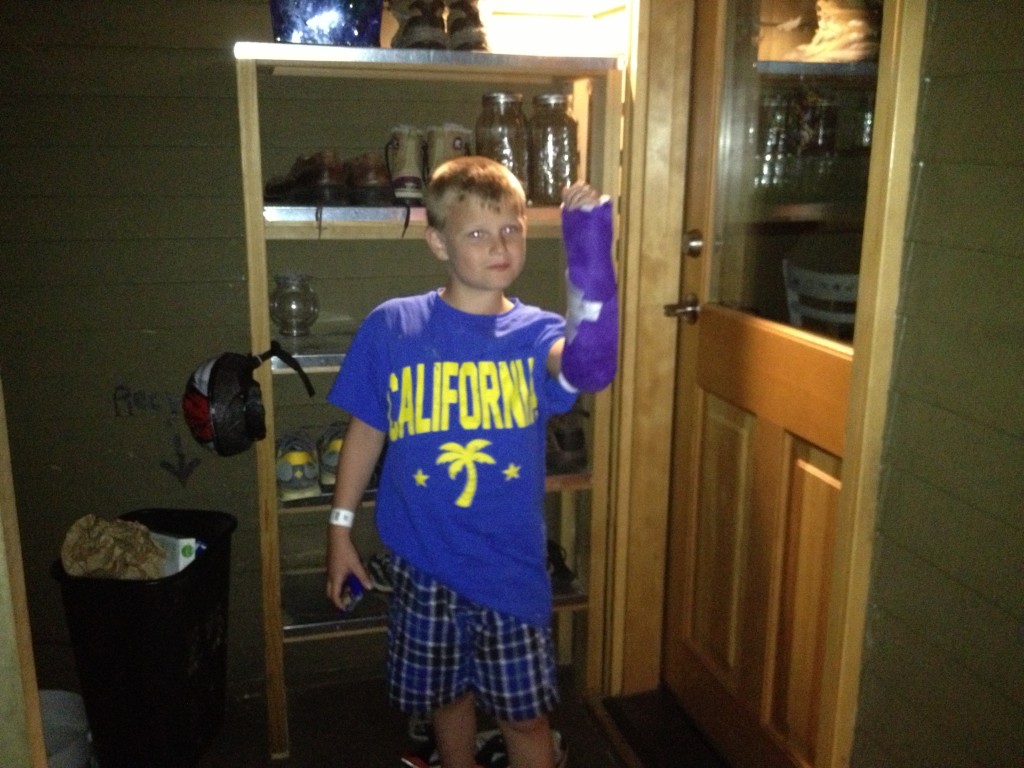Adding Injury to Insult
 My 8-year old son broke his arm recently.
My 8-year old son broke his arm recently.
I know most parents of boys utter similar words at some time during their tenure as a parent; it’s practically inevitable… or at least it seems inevitable if you have a boy—especially if you have more than one boy!
Each of my boys has had some incident requiring stitches and some kind of break (except for Charlie who hasn’t reached “break” age yet – since he’s only 5!*) Cole broke his arm and split his chin open (separate incidents), A.J. broke his arm and split his chin open (separate incidents), and Avi split his forehead open years ago and finally – just this fall – joined the “club” of having broken his arm! In nearly every case it’s been a sports-related injury involving playground equipment or a bicycle—like I said, almost inevitable!
However, when you have children who have been lead-poisoned, events like a broken arm take on an added dimension and seem oddly different. Unlike his brothers, Avi didn’t break his arm on the playground or falling off his bike—he fell off his feet onto the pavement, because he was having an “OCD moment” and running excitedly/wildly (to the game store around the corner from our house), not paying any attention to his body or his surroundings!
We had just returned from a trip to California—where he had a blast swimming in the waves and riding his new boogie board. Many lead-poisoned children like Avi suffer from OCD as an impact of their lead-exposure. While OCD is painful and destructive at times (think about the times you can’t get them away from their video games) OCD can actually at times be a “good” thing—if you find something constructive and healthy the child likes to do…when an OCD child finds a thing they like to do, they will pretty much do it forever—until you drag them kicking and screaming away from it. This is how it was when Avi discovered boogie boarding…he didn’t want to ever stop (he was in the water continuously for hours!); luckily it was a warm day and there were plenty of other children around (as well as lifeguards and a safe environment)—he had a marvelous time!
In returning to Oregon from California, Avi was “amped up”—he was hyper-focused on sharing his experience boogie-boarding, while also exhibiting some high-strung anxiety which manifested in an OCD interest in getting back to his old patterns…including going to the game store. As a result of his level of excitement/excitation coming home (something that was beyond the realm of how a normal/ non-lead-poisoned child would have acted upon returning home from a trip) he ran at break-neck (“break-arm”?) speed to the game store, tripped and fell—and broke his arm!
When I say “adding Injury to Insult” what I am getting at is that in this case his lead-poisoning-influenced behavior patterns seem to have been the primary factor in this unusual/seemingly avoidable injury. To some it may seem like a stretch, but to me it was obvious: had he not been so hyper and excited because he was obsessing on things coming home, he would not have been running down the sidewalk with such reckless abandon, he may have had a better sense of his body moving through space—and he would not likely have tripped and “crashed” so violently to the ground, breaking his arm!
Events like this are never considered in tabulating the cost (direct or indirect) of childhood lead poisoning. In this case, it was not just the cost of the break and the cost of my lost time at work (waiting at the hospital, getting casts replaced, managing his OCD over how the cast was feeling on his arm because of his SPD [Sensory Processing Disorder]) – but the impact of the incident on Avi—how these types of incidents can shape children’s choices and color their self-perception and view of their environment and life.
When dealing with a lead-poisoned child, so many “incidents” can often linked in some-way to their lead-exposure. The lead-poisoning becomes a permanent factor in that child’s life, in many cases, something to be managed, considered and dealt with in every choice in that child’s life. For these children, if you make a choice without taking into account the potential implications as a result of the child’s lead-poisoning, you generally regret it.
While parents of a singleton child might have more questions/doubts about such linked behavior and incidents, I have my own “control group” with my four kids, book-ends of a sort – the oldest and youngest did not have the acute lead-exposure and the two middle ones did.
In our family, the impacts seem quite clear.
*UPDATE: Since I wrote this, Charlie had his very own first dramatic fall requiring stitches (a single stitch to be precise) when he slipped off a log and landed face-first onto a jagged rock (OUCH!); oy—I’m fantasizing about dressing them in full body armor before letting them leave the house right about now!
Tamara Rubin
November 3, 2013
Never Miss an Important Article Again!
Join our Email List


